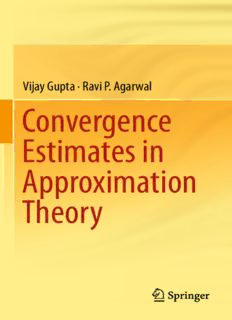
Convergence Estimates in Approximation Theory PDF
Preview Convergence Estimates in Approximation Theory
Vijay Gupta · Ravi P. Agarwal Convergence Estimates in Approximation Theory Convergence Estimates in Approximation Theory Vijay Gupta • Ravi P. Agarwal Convergence Estimates in Approximation Theory 123 VijayGupta RaviP.Agarwal SchoolofAppliedSciences DepartmentofMathematics NetajiSubhasInstituteofTechnology TexasA&MUniversity-Kingsville NewDelhi,India Kingsville,TX,USA ISBN978-3-319-02764-7 ISBN978-3-319-02765-4(eBook) DOI10.1007/978-3-319-02765-4 SpringerChamHeidelbergNewYorkDordrechtLondon LibraryofCongressControlNumber:2013956134 MathematicsSubjectClassification(2010):41A36,41A25,41A17,30E10 ©SpringerInternationalPublishingSwitzerland2014 Thisworkissubjecttocopyright.AllrightsarereservedbythePublisher,whetherthewholeorpartof thematerialisconcerned,specificallytherightsoftranslation,reprinting,reuseofillustrations,recitation, broadcasting,reproductiononmicrofilmsorinanyotherphysicalway,andtransmissionorinformation storageandretrieval,electronicadaptation,computersoftware,orbysimilarordissimilarmethodology nowknownorhereafterdeveloped.Exemptedfromthislegalreservationarebriefexcerptsinconnection with reviews or scholarly analysis or material supplied specifically for the purpose of being entered and executed on a computer system, for exclusive use by the purchaser of the work. Duplication of this publication or parts thereof is permitted only under the provisions of the Copyright Law of the Publisher’slocation,initscurrentversion,andpermissionforusemustalwaysbeobtainedfromSpringer. PermissionsforusemaybeobtainedthroughRightsLinkattheCopyrightClearanceCenter.Violations areliabletoprosecutionundertherespectiveCopyrightLaw. Theuseofgeneraldescriptivenames,registerednames,trademarks,servicemarks,etc.inthispublication doesnotimply,evenintheabsenceofaspecificstatement,thatsuchnamesareexemptfromtherelevant protectivelawsandregulationsandthereforefreeforgeneraluse. While the advice and information in this book are believed to be true and accurate at the date of publication,neithertheauthorsnortheeditorsnorthepublishercanacceptanylegalresponsibilityfor anyerrorsoromissionsthatmaybemade.Thepublishermakesnowarranty,expressorimplied,with respecttothematerialcontainedherein. Printedonacid-freepaper SpringerispartofSpringerScience+BusinessMedia(www.springer.com) Preface Theaimofthegeneralapproximationmethodsconcerninglinearpositiveoperators istodealwithconvergencebehavior.Theaccuracycanbeascertainedtoadesired degree by applying different methods. We are also concerned with the amountof computationrequiredtoachievethisaccuracy.Adirecttheoremprovidestheorder ofapproximationforfunctionsofspecifiedsmoothness.Theconverseofthedirect result,thatis, the inversetheorem,infersthe natureofsmoothnessofthe function fromitsorderofapproximation.Asymptoticanalysisisakeytoolforexploringthe ordinaryandpartialdifferentialequationsthatarise in the mathematicalmodeling of real-world phenomena. The rate of convergence infers the speed at which a convergentsequenceapproachesitslimit. This work treats the convergence results mainly for linear positive operators. After the well-known theorem due to Weierstrass and the important convergence theoremofKorovkin,manynewoperatorswereproposedandconstructedbyseveral researchers.Thetheoryoftheseoperatorshasbeenanimportantareaofresearchin thelastfewdecades.Thebasicresultsanddirectestimatesinbothlocalandglobal approximationarealsopresented.Wealsodiscusstheasymptoticexpansionofsome of the linear positive operators,which is importantfor convergenceestimates. We knowthattoimprovetheorderofapproximation,wecanconsiderthecombinations. Byconsideringthelinearcombinations,wehavetoslackenthepositivityconditions of the operators. Here we discuss linear and iterative combinations and present someresults.Someoperatorsreproduceconstantandlinearfunctions.Twodecades agoitwas observedthatif we modifythe originaloperators,we canhave a better approximation.Latersomeresearchersstudiedthisdirectionandobservedthatsome operatorsthatdonotevenpreservelinearfunctionscangiveabetterapproximation iftheyaremodifiedtopreservelinearfunctions.Theoverconvergencephenomena for certain operators, which were not discussed in the book by Gal, [77] are also discussed here. We presentsome results of overconvergenciesto largersets in the complexplane. Inthisbook,thecrucialroleoftherateofconvergenceforfunctionsofbounded variationandforfunctionshavingderivativesofboundedvariationisemphasized. New and efficient methods that are applicable to general operators are also v vi Preface discussed.Theadvantagesofthesemethodsconsistofobtainingimprovedandeven optimalestimates,aswellasofbroadeningtheapplicabilityoftheresults.Several results have been established for different exponential-typeoperators and integral operators. Still, this type of study can be extended to other generalizationsof the knownoperators.Also,therateofconvergenceforfunctionsofboundedvariation on mixed summation–integral-typeoperators having different basis functions has not been studied to date, including Szász–Baskakov, Baskakov–Szász, and Beta– Szászoperators,amongothers.Itcanbeconsideredanopenproblem.Wemention someresultswithoutproofs,whileinothercases,proofsandoutlinesaregiven.The bookisusefulforbeginnersandforthosewhoareworkingonanalysisandrelated areas. Thismonographisdividedinto11chapters: InChap.1,whichisintroductoryinnature,wepresentsomebasicdefinitionsand thestandardtheorems,whichareimportantfortheconvergencepointofview. In Chap.2, we discuss some important results on linear positive operators relatedtoconvergence.Somedirectresults,whichincludepointwiseconvergence, asymptotic formulas, and error estimations, are presented here. We also deal with some important results, including discretely defined operators, Kantorovich- and Durrmeyer-typeoperators,mixed summation–integral-typeoperators,Phillips operators,andotherintegral-typeoperators. In Chap.3, we discuss the asymptotic behavior of some of the linear positive operators. We discuss the complete asymptotic expansion of the Baskakov– Kantorovich, Szász–Baskakov, Meyer–König–Zeller–Durrmeyer, and Beta operators. In Chap.4, we mention approximation for certain combinations. The linear combinations are no longer positive operators. Here we study some results for linear and iterative combinations.Also, we consider a differentform of the linear combinations and present direct estimates for combinations of Szász–Baskakov operators. In Chap.5,we presentthe techniquesforgettinga better approximation.Many well-known approximating operators L ; preserve the constant as well as linear n functions. In 1983, King considered the modification of the classical Bernstein polynomials so that the modified form preserves the test function e : A better 2 approximationcan be achieved for the modified form. In this chapter, we present someresultsfordifferentoperatorsdiscussedinrecentyears. In Chap.6, we study the overconvergence phenomenon for certain operators that were not discussed in the book by Gal [77]. We present some results of overconvergenciestolargersetsin the complexplanethanin the realdomain.We discusssomeveryrecentresultsoncomplexBaskakov–Stancuoperators,complex Favard–Szász–Mirakjan–Stancu operators, complex Beta operators of the second kind, genuine Durrmeyer–Stancu polynomials, and certain complex Durrmeyer- typeoperators. In Chap.7, the pointwise approximation properties of some approximation operators of the probabilistic type are established and studied. The rates of convergenceforLegendre–Fourierseries,Hermite–Fejérpolynomials,exponential- Preface vii typeoperators(whichincludeBernstein,Szász,Baskakov,Gamma,andWeierstrass operators) are also discussed. The rates of convergence of such operators for a bounded variation function f are given at those points x; where f.xC/ and f.x(cid:2)/exist.HerewealsopresentsomeresultsontheDurrmeyervariantsofsuch operators. We also present the related results for a general class of summation– integral-typeoperatorsandtheMeyer–KönigandZelleroperators. In Chap.8, we discuss various Bézier variants of the approximation opera- tors. They have close relationships with the fields of geometry modeling and design. In this chapter, we present some important results on the approximation of Bézier variants of a series of approximation operators, which include Bézier variants of the Bernstein, Bleimann–Butzer–Hann, Balazs–Kantorovich, Szász– Kantorovich,Baskakov, Baskakov–Kantorovich,Baskakov–Durrmeyer,and MKZ operators,amongothers. In Chap.9, we study some otherrelated results. We presentthe rate of approx- imation on nonlinearoperators.Also, we discuss the rate of convergencein terms of Chanturiya’s modulus of variation. We also present some results for bounded andabsolutelycontinuousfunctions.Finally,wepresenttherateofconvergencefor functionshavingderivativescoincidinga.e.withthefunctionofboundedvariation. InChap.10,wepresentresultsrelatedtosimultaneousapproximation.Although lot of papers have appeared on such topic, in this chapter we mention the rate of simultaneousapproximationfor certain Durrmeyer–Bézieroperatorsfor functions of bounded variation. We also present the rate of convergence in simultaneous approximationforcertainsummation–integral-typeoperatorshavingderivativesof boundedvariation. Inthebrieffinalchapter,Chap.11,wepresentthefuturescopeofrelatedtopics andmentionsomeopenproblems. NewDelhi,India VijayGupta Kingsville,TX,USA RaviP.Agarwal Acknowledgments Idedicatethisbookinthememoryofmyfather,thelateP.D.Gupta(1935–1996), whoinspiredandencouragedmeto optformathematicsasmymainsubjectatan earlystage.I amindebtedto mymother,UmaGupta,forherconstantblessings.I appreciate the constant support of my wife, Shalini, and my children, Arushi and Anshay,ateachstageofthisbook’swriting. -VijayGupta Idedicatethisbookinthememoryofmyfather,thelateRadheyShiamAgarwal. -RaviP.Agarwal ix
Description: